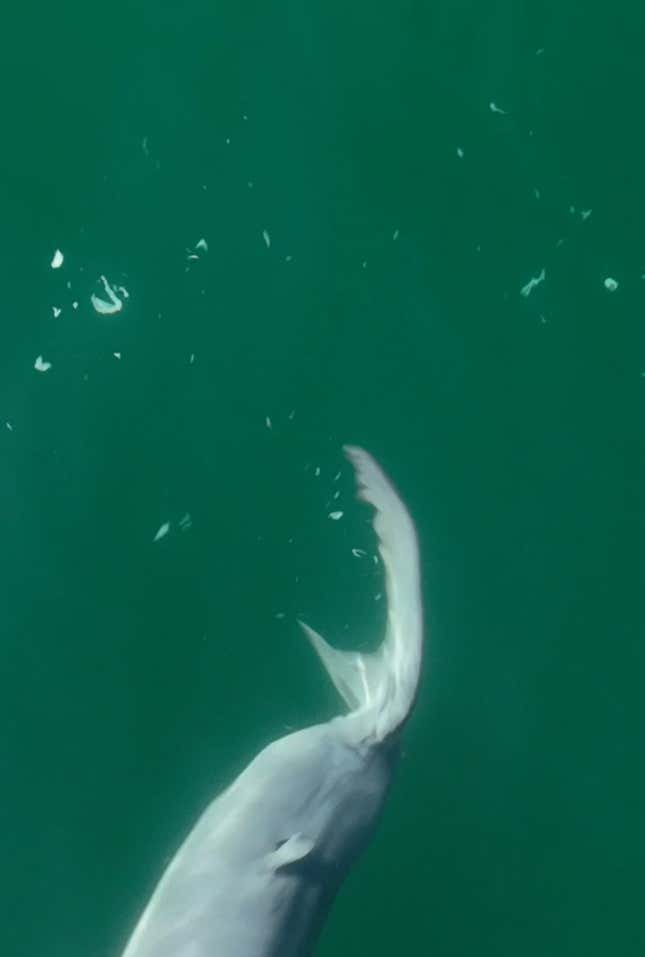Living Newborn Great White Shark Seen for the First Time Ever
Footage taken off the coast of Santa Barbara has captured something new to science: a living newborn great white shark. The shark’s discovery could help researchers finally learn where white sharks—one of the ocean’s top predators—birth their young.
The 5-foot-long pup was photographed by drone in July 2023; it was covered in a thin, whitish film, the major clue that the shark was born recently. It may have had a skin condition, the researchers say, but it’s more likely that it was still covered with its embryonic layer. The drone footage and a paper describing the findings are published today in Environmental Biology of Fishes.
“Capturing the actual birth is the holy grail of shark science. What I filmed is simply a clue that gets us closer to it,” said Carlos Guana, the wildlife filmmaker who captured the footage and co-author of the study, in an email to Gizmodo. “The piece of the puzzle this footage provides does have the potential to change the direction of where we should be looking and maybe even bigger implications for what areas should be protected.”
White sharks are a formidable but vulnerable species, threatened by human bycatch and poaching. They have several hundred teeth, and the largest individuals can grow to be 20 feet long. Despite the extent to which great whites capture our imagination, precious little is known about how they are born.
The recently spotted shark was much smaller than an adult—like, fresh-out-the-womb smaller. The baby shark bore two signs it was a newborn, the first being a whitish film cloaking its body. The researchers posit that the pale film was made of some intrauterine substances that remained stuck to the animal. Pregnant female white sharks produce a fluid called uterine milk, which shark embryos consume, according to study co-author Phillip Sternes. White sharks consume this fluid as well as other eggs in their mother’s uterus.
But the shark’s age was corroborated by its shape—more specifically, the shape of its “rounded, underdeveloped dorsal fin,” Guana said, adding that the fin looked like the dorsal fins of unborn sharks found inside dead pregnant sharks.
“The skin disorder explanation fails to take into account the fins, especially the dorsal fin,” he added. “I don’t believe a skin disorder exists that changes the shape of a dorsal fin.”
Spotting such a young great white shark so close to the shore could change scientists’ expectations for where these births occur. Despite how large these sharks loom in the public consciousness, we actually know very little about their habits or even how long they live.
More: Great White Sharks Appear Perfectly Healthy Despite Lead, Arsenic, and Mercury Coursing Through Their Veins
Footage taken off the coast of Santa Barbara has captured something new to science: a living newborn great white shark. The shark’s discovery could help researchers finally learn where white sharks—one of the ocean’s top predators—birth their young.
The 5-foot-long pup was photographed by drone in July 2023; it was covered in a thin, whitish film, the major clue that the shark was born recently. It may have had a skin condition, the researchers say, but it’s more likely that it was still covered with its embryonic layer. The drone footage and a paper describing the findings are published today in Environmental Biology of Fishes.
“Capturing the actual birth is the holy grail of shark science. What I filmed is simply a clue that gets us closer to it,” said Carlos Guana, the wildlife filmmaker who captured the footage and co-author of the study, in an email to Gizmodo. “The piece of the puzzle this footage provides does have the potential to change the direction of where we should be looking and maybe even bigger implications for what areas should be protected.”

White sharks are a formidable but vulnerable species, threatened by human bycatch and poaching. They have several hundred teeth, and the largest individuals can grow to be 20 feet long. Despite the extent to which great whites capture our imagination, precious little is known about how they are born.
The recently spotted shark was much smaller than an adult—like, fresh-out-the-womb smaller. The baby shark bore two signs it was a newborn, the first being a whitish film cloaking its body. The researchers posit that the pale film was made of some intrauterine substances that remained stuck to the animal. Pregnant female white sharks produce a fluid called uterine milk, which shark embryos consume, according to study co-author Phillip Sternes. White sharks consume this fluid as well as other eggs in their mother’s uterus.
But the shark’s age was corroborated by its shape—more specifically, the shape of its “rounded, underdeveloped dorsal fin,” Guana said, adding that the fin looked like the dorsal fins of unborn sharks found inside dead pregnant sharks.
“The skin disorder explanation fails to take into account the fins, especially the dorsal fin,” he added. “I don’t believe a skin disorder exists that changes the shape of a dorsal fin.”
Spotting such a young great white shark so close to the shore could change scientists’ expectations for where these births occur. Despite how large these sharks loom in the public consciousness, we actually know very little about their habits or even how long they live.
More: Great White Sharks Appear Perfectly Healthy Despite Lead, Arsenic, and Mercury Coursing Through Their Veins
